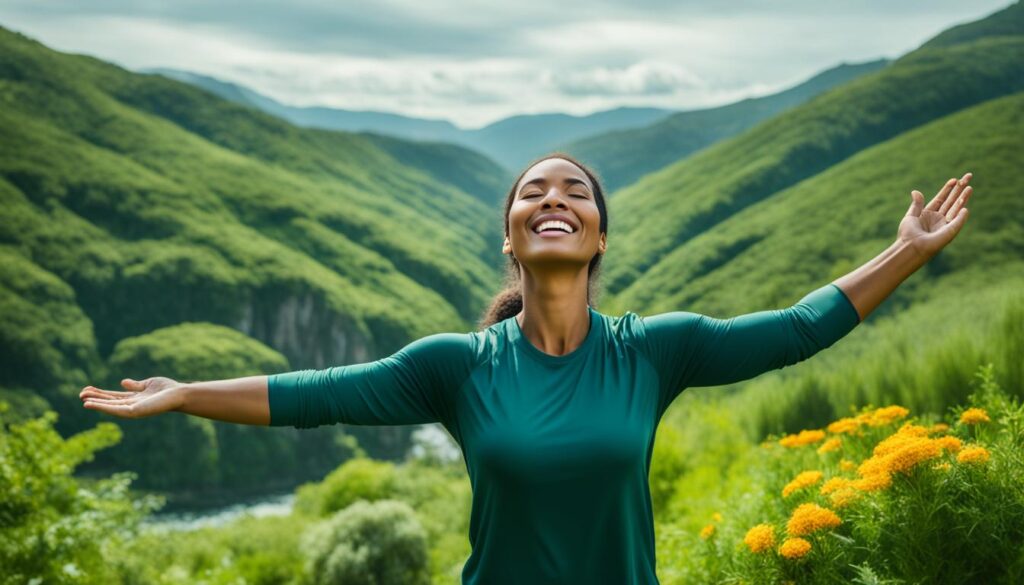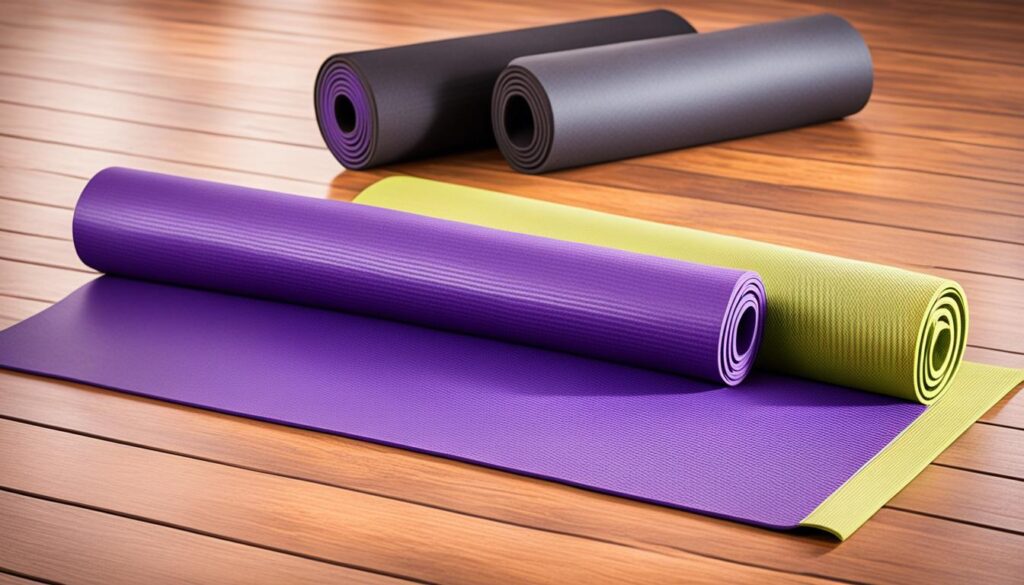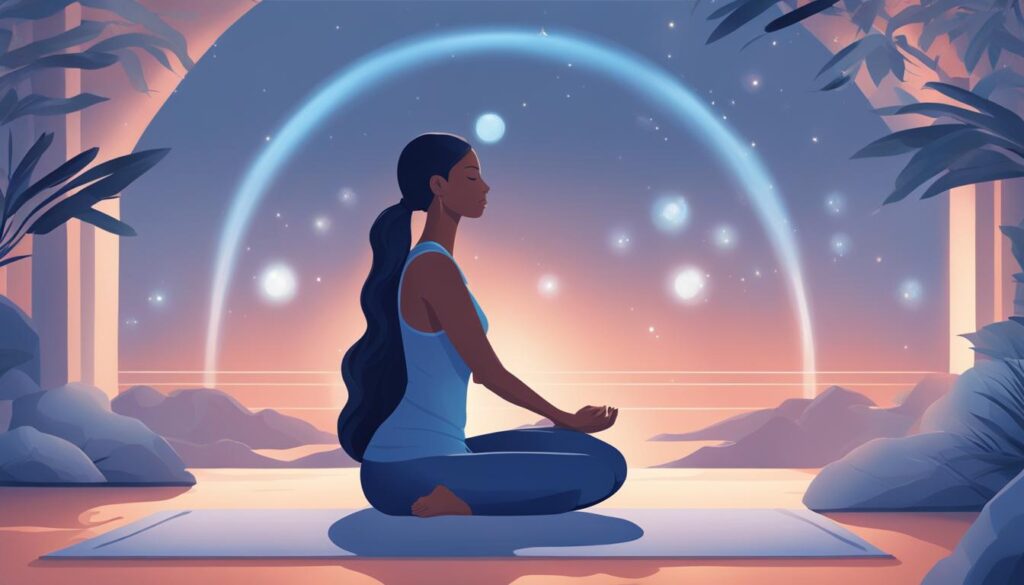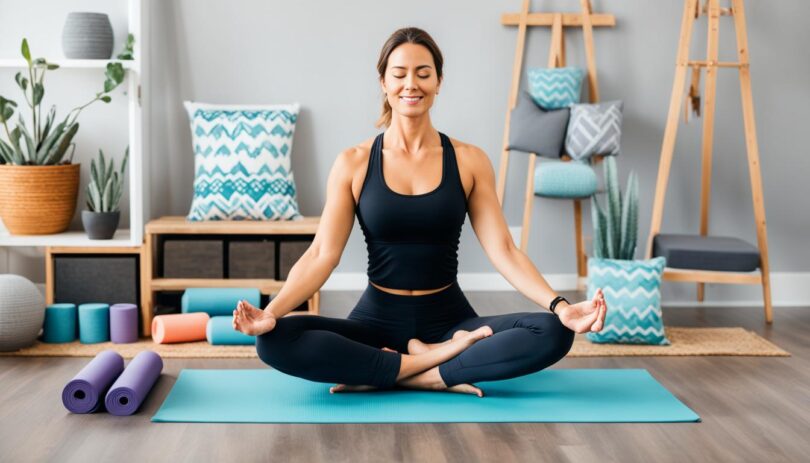If you’re new to the world of yoga, taking those first steps on your journey can be daunting. You might have a lot of questions, like “What kind of yoga should I start with?” or “What equipment do I need?”. It can feel overwhelming, but fear not! In this comprehensive guide, I will provide you with a step-by-step approach to starting your yoga practice as a beginner. Here, you’ll learn everything from basic poses, breathing techniques, and essential equipment, to yoga routines that work for your schedule.
Key Takeaways
- Understand the benefits of yoga for beginners.
- Learn about essential equipment and attire to create a safe and comfortable practice space.
- Explore different breathing and yoga techniques for beginner yogis.
- Discover basic yoga poses that build strength, flexibility, and balance.
- Create a personalized yoga routine that suits your schedule and goals as a beginner.
The Benefits of Yoga for Beginners
Yoga offers a wealth of benefits for beginners looking to start their practice. Whether you’re looking to improve your physical health, reduce stress and anxiety, or cultivate mindfulness and inner peace, yoga has something to offer for everyone.
Improved Physical Health
One of the most obvious benefits of a regular yoga practice is improved physical health. As a beginner, you’ll quickly notice improvements in flexibility, strength, and balance. Yoga can also help improve posture and alignment, reducing the likelihood of injury in other physical activities. Plus, regular yoga practice has been linked to a host of physical health benefits, including:
| Benefit | Description |
|---|---|
| Lower blood pressure | Yoga has been shown to help reduce high blood pressure in some people |
| Better cardiovascular health | Yoga can help improve circulation and heart health |
| Improved digestion | Yoga can help stimulate digestion and relieve digestive issues |
Tip: Don’t worry if you’re not flexible or strong when starting your yoga journey. Yoga is a practice, not a perfection, and progress happens over time with consistent effort.
Reduced Stress and Anxiety
Another major benefit of yoga is its ability to reduce stress and anxiety. The combination of physical movement, breath control, and meditation can help calm the nervous system and promote relaxation. Regular yoga practice has been shown to help reduce stress and anxiety levels in people of all ages and backgrounds.
Increased Mindfulness and Inner Peace
Finally, practicing yoga can help cultivate mindfulness and inner peace, which can have a positive impact on mental health and well-being. By bringing attention to the present moment and focusing on the breath, yoga can help quiet the mind and reduce feelings of stress and overwhelm. Over time, regular yoga practice can lead to greater self-awareness, clarity, and inner peace.

Overall, the benefits of yoga for beginners are numerous and far-reaching. Whether you’re looking to improve your physical health, reduce stress and anxiety, or cultivate mindfulness and inner peace, yoga offers a powerful practice for transformation and growth.
Getting Started: Essential Equipment and Attire
If you’re new to yoga, it’s important to have the right equipment and attire to ensure a safe and comfortable practice. Here are some essentials you’ll need to get started:
Yoga Mat
The yoga mat is the foundation of your practice. It provides a non-slip surface that cushions your joints and helps prevent injuries.

Look for a mat with good grip and enough cushioning for your body type. Some popular brands include Manduka, Liforme, and JadeYoga.
Yoga Props
Props such as blocks, straps, and blankets can help you modify poses and provide support as you build strength and flexibility.
Blocks can be used to bring the floor closer to you in standing poses, while straps can help you reach deeper stretches. Blankets can be used to cushion your joints or provide warmth during relaxation poses.
Comfortable Clothing
Choose clothing that allows for a full range of motion and is breathable. Avoid loose clothing that may get in the way of your practice or distract you during poses.
Popular brands for yoga clothing include Lululemon, Athleta, and Alo Yoga.
Other Considerations
In addition to the above essentials, you may also want to consider investing in a non-slip towel to place on top of your mat, especially if you tend to sweat during your practice. You may also want to have a water bottle nearby to stay hydrated.
With these basic essentials, you’ll be ready to create a comfortable and safe practice space as you begin your yoga journey.
Breathing Techniques for Beginner Yogis
Yoga is not just about physical postures. One of its essential elements is breath work, or pranayama. Breath control helps to calm the mind, energize the body, and find focus during your practice. As a beginner yogi, it’s crucial to learn and practice different breathing techniques to deepen your yoga experience.
Here are some simple yet effective breathing techniques that you can try:
1. Deep Belly Breathing
This technique focuses on breathing deeply into your belly instead of just your chest. Sit or lie down in a comfortable position and place one hand on your belly and the other on your chest. Inhale deeply through your nose and feel your belly expand with your breath, then exhale slowly through your mouth, feeling your belly sink back in. Repeat this for a few minutes.
2. Ujjayi Breath
Also known as ocean breath, ujjayi breath involves inhaling deeply through your nose while slightly contracting the back of your throat, then exhaling through your mouth with a similar contraction. This creates an audible sound similar to waves in the ocean. This technique helps to calm the mind and focus your attention.
3. Alternate Nostril Breathing
This technique involves breathing through one nostril at a time while closing the other nostril with your fingers. Sit comfortably and place your left hand on your left knee, then use your right hand to close your right nostril. Inhale deeply through your left nostril, then use your ring finger to close the left nostril and exhale through the right nostril. Repeat this pattern, inhaling through the right and exhaling through the left, for a few minutes.

“Breath is the bridge which connects life to consciousness, which unites your body to your thoughts. Whenever your mind becomes scattered, use your breath as the means to take hold of your mind.”
As you integrate breathing techniques into your yoga practice, remember to pay attention to your body and take it at your own pace. Breathing should feel natural and comfortable, not forced or strained.
Basic Yoga Poses for Beginners
If you’re new to yoga, approaching the vast world of yoga poses can seem overwhelming. However, starting with a few basic poses can help you build confidence and establish a strong foundation for your practice. These basic poses are perfect for beginners:
| Pose | Description |
|---|---|
| Mountain Pose | Stand tall with your feet hip-distance apart and your arms at your sides. Ground down through your feet, lift your chest, and engage your core. |
| Downward Facing Dog | Begin on all fours with your hands shoulder-distance apart and your knees hip-distance apart. Lift your hips and press into your hands and feet to form an inverted V-shape. |
| Child’s Pose | From all fours, sit back on your heels and lower your forehead to the ground. Reach your arms forward or rest them at your sides. |
| Warrior 1 | From mountain pose, step your left foot back and angle it out slightly. Bend your right knee and lift your arms overhead, gazing up at your hands. |
| Tree Pose | Stand tall and shift your weight onto your left foot. Place your right foot on your inner left thigh and press your foot and thigh together. Bring your hands to your heart or lift them overhead. |
These simple poses can help you build strength, flexibility, and balance in your body. As you become more comfortable with these foundational poses, you can begin to explore more advanced postures and sequences.

Developing a Yoga Routine for Beginners
Starting a consistent yoga routine is a crucial step in your yoga practice. A routine allows you to progress in your practice and reap the full benefits of yoga. Here, I’ll walk you through how to create a personalized yoga routine that suits your schedule and goals as a beginner yogi, using these 5 easy steps:
1. Determine your goals
First, identify your goals for starting a yoga practice. Do you want to increase flexibility, build strength, reduce stress, or improve overall well-being? Having clarity about your goals will help you decide what type of yoga routine to develop.
2. Choose a routine that suits your schedule
Next, decide on a routine that you can fit into your daily schedule. It’s better to start with a shorter routine that you can comfortably commit to than to overcommit and get discouraged. You can start with as little as 10 minutes a day and gradually increase the duration.
3. Select yoga poses
Choose yoga poses that align with your goals and routine length. For example, if your goal is to increase flexibility and you only have 15 minutes a day, select simple stretches such as seated forward bend, butterfly pose, and cow-cat pose. Make sure to include warm-up and cool-down poses, as these will help prevent injury.
4. Have a balanced routine
A balanced yoga routine should involve poses that strengthen your lower and upper body, as well as poses that stretch your muscles. This will help prevent muscle imbalances and injury. Consult with a yoga teacher to design a routine that meets your goals and needs.
5. Track your progress
Track your progress to stay motivated and achieve your goals. Document the poses you practice, the duration, and how you feel before and after the practice. This will help you adjust your routine to meet your goals and needs.
Remember, developing a yoga routine takes time and practice to find what works best for you. Be patient with yourself and enjoy the process. Happy yoga-ing!
Tips for Practicing Yoga Safely
As a beginner, practicing yoga can be daunting, but it doesn’t have to be. Practicing yoga safely is crucial to prevent any injuries, especially as you explore new poses. Here are a few essential tips and precautions to keep in mind when you are starting your yoga practice:
Listen to your body
One of the most vital things to keep in mind while practicing yoga is to listen to your body. Do not push yourself into any pose that feels uncomfortable or painful. Remember that everyone’s body is different, and what works for one person may not work for you.
Warm-up is a must
Before starting your yoga practice, it’s crucial to warm up your body correctly. Warming up improves your flexibility and performance, reduces the risk of injury, and prepares your mind and body for the practice.
Use Props
Props like blocks, straps, blankets, or bolsters can be a great help when it comes to modifying poses or maintaining proper alignment. Using props reduces the risk of injury and makes poses more accessible and comfortable for you.

“When you find peace within yourself, you become the kind of person who can live at peace with others.” – Peace Pilgrim
Breathe and Stay Hydrated
Remember to breathe continuously and deeply throughout your yoga practice. Proper hydration before, during, and after your practice is also essential as it helps your body to function correctly.
Practice Consistency and Patience
Yoga is a practice that requires consistency and patience. Practicing yoga consistently helps you develop flexibility, strength, and focus. Patience helps you understand that change takes time, and not to push yourself too hard to avoid injury.
By following these essential tips, you can practice yoga safely and confidently. Remember to take it easy, breathe, warm up properly, use props, listen to your body and be patient with yourself. Namaste.
Exploring Different Styles of Yoga
As a beginner, it’s essential to explore the different styles of yoga and find one that resonates with you. Some of the most popular yoga styles for beginners include:
| Style | Description |
|---|---|
| Hatha | A gentle, slower-paced style that involves holding poses for longer periods, making it a great option for beginners who want to focus on correct alignment and breathing techniques. |
| Vinyasa | A dynamic, flowing style in which movements are synchronized with the breath. Vinyasa classes tend to be challenging and can help you build strength and endurance. |
| Yin | A slower-paced, passive style that involves holding poses for several minutes. Yin yoga helps improve flexibility and encourages relaxation. |
Of course, these are just a few examples of the many different yoga styles out there. Don’t be afraid to try different styles until you find one that feels right for you.
Remember to always listen to your body and choose a style that accommodates your level of fitness and flexibility.
Modifying Poses for Your Body and Comfort
As a beginner in yoga, it’s important to listen to your body and avoid pushing beyond your comfort zone. Every body is unique, and some poses may require modifications to make them accessible and safe for you. Here are some tips to modify yoga poses to meet your individual needs and avoid strain or injury in your practice:
- Use props: Yoga props like blocks, straps, and blankets can help you modify poses and make them more accessible. For example, using a block under your hand in Triangle Pose can help you reach the floor without straining or compromising your alignment.
- Adjust your stance: Changing the width or length of your stance can modify the intensity of a pose. For example, widening your stance in Warrior I can make the pose more stable and comfortable for beginners.
- Take it slow: Don’t rush into deep poses or advanced variations. Move gradually and mindfully, paying attention to your breath and any sensations in your body.
- Ask for help: If you’re unsure about how to modify a pose, don’t hesitate to ask your yoga teacher for guidance. They can offer personalized modifications and adjustments to suit your needs.
Remember, yoga is not about perfection or performing the most challenging pose, but rather about connecting with your body, breath, and mind. Prioritize safety, comfort, and self-care in your practice for a fulfilling and sustainable yoga journey.
Deepening Your Yoga Practice as a Beginner
As a beginner yogi, starting your practice can be both exciting and daunting. Once you become comfortable with the basics and have established a regular routine, you may want to explore more challenging poses and techniques to deepen your practice.
One way to challenge yourself is to incorporate props into your practice, such as blocks, straps, or bolsters. These tools can help you access and hold postures that may otherwise be difficult, allowing you to deepen your stretches and build strength over time.
Another way to advance your practice is to explore more advanced yoga poses, such as inversions or arm balances. It’s important to approach these poses with caution and seek guidance from a qualified yoga instructor to ensure proper alignment and prevent injuries.
Additionally, consider exploring different styles of yoga, such as Ashtanga or Kundalini, that may offer a new and unique perspective on your practice.
Lastly, remember to always listen to your body and be patient with yourself as you navigate your yoga journey. Embrace the challenges and enjoy the rewards of starting your practice and expanding your understanding of yourself through beginner’s yoga.
Conclusion
In conclusion, starting a yoga practice as a beginner can be intimidating, but with this comprehensive guide, you can embark on your yoga journey with confidence and ease. Remember to start with the basics, explore different poses and techniques gradually, and create a safe and comfortable practice space. Always keep in mind the benefits of yoga, not just for your physical health but also for your mental and emotional well-being.
Develop a consistent yoga routine that suits your goals and schedule, and modify poses if necessary to avoid injury and make them accessible to your unique needs. As you progress, don’t be afraid to challenge yourself and explore different styles of yoga to deepen your practice further.
Finally, listen to your body and practice with mindfulness and intention. Embrace the transformative power of yoga as a beginner and unlock your full potential on and off the mat.
FAQ
What are the benefits of practicing yoga as a beginner?
As a beginner, practicing yoga has numerous benefits. It can improve flexibility and strength, reduce stress and anxiety, enhance mindfulness, promote better sleep, and boost overall well-being.
What equipment and attire do I need to start practicing yoga?
To start practicing yoga, you will need a yoga mat, which provides cushioning and grip. Depending on the style of yoga you choose, you may also need additional props such as blocks, straps, and blankets. Additionally, wearing comfortable and breathable clothing that allows freedom of movement is essential.
Can you explain some basic breathing techniques for beginners?
Absolutely! Some basic breathing techniques for beginners include deep belly breathing (also known as diaphragmatic breathing), alternate nostril breathing, and the ocean breath (also known as Ujjayi breathing). These techniques can help you relax, focus your mind, and connect with your breath during your yoga practice.
What are some basic yoga poses that beginners can start with?
As a beginner, you can start with foundational yoga poses such as Mountain Pose (Tadasana), Downward-Facing Dog (Adho Mukha Svanasana), Child’s Pose (Balasana), Warrior I (Virabhadrasana I), and Bridge Pose (Setu Bandhasana). These poses provide a solid foundation for building strength, flexibility, and body awareness.
How can I develop a yoga routine as a beginner?
Developing a yoga routine as a beginner involves setting aside dedicated time for your practice and choosing a sequence of poses that suits your needs and goals. It’s important to start slowly and gradually increase the duration and intensity of your practice as you become more comfortable. Consistency is key to progress in yoga.
Any tips for practicing yoga safely as a beginner?
Yes, practicing yoga safely as a beginner is crucial. Start by listening to your body and respecting your limits. Warm up properly before attempting more challenging poses, use props to support your practice, and always practice on a non-slip surface. If you have any pre-existing injuries or medical conditions, consult with a healthcare professional or a certified yoga instructor for guidance.
What are some popular styles of yoga for beginners?
Some popular styles of yoga for beginners include Hatha yoga, which focuses on gentle movements and breathing techniques; Vinyasa yoga, which emphasizes flowing sequences and breath coordination; and Yin yoga, which involves holding poses for longer periods to improve flexibility and promote relaxation.
How can I modify poses to suit my body and comfort level?
Everyone’s body is unique, and it’s important to modify poses to suit your individual needs. This may involve using props, adjusting the alignment of your body, or choosing variations of poses that feel more accessible and comfortable for you. A certified yoga instructor can guide you in making these modifications.
How can I deepen my yoga practice as a beginner?
To deepen your yoga practice as a beginner, you can explore more challenging variations of basic poses, try different styles of yoga, attend workshops or retreats, and deepen your understanding of yoga philosophy and principles. It’s important to progress at your own pace and always listen to your body.


Leave a Comment